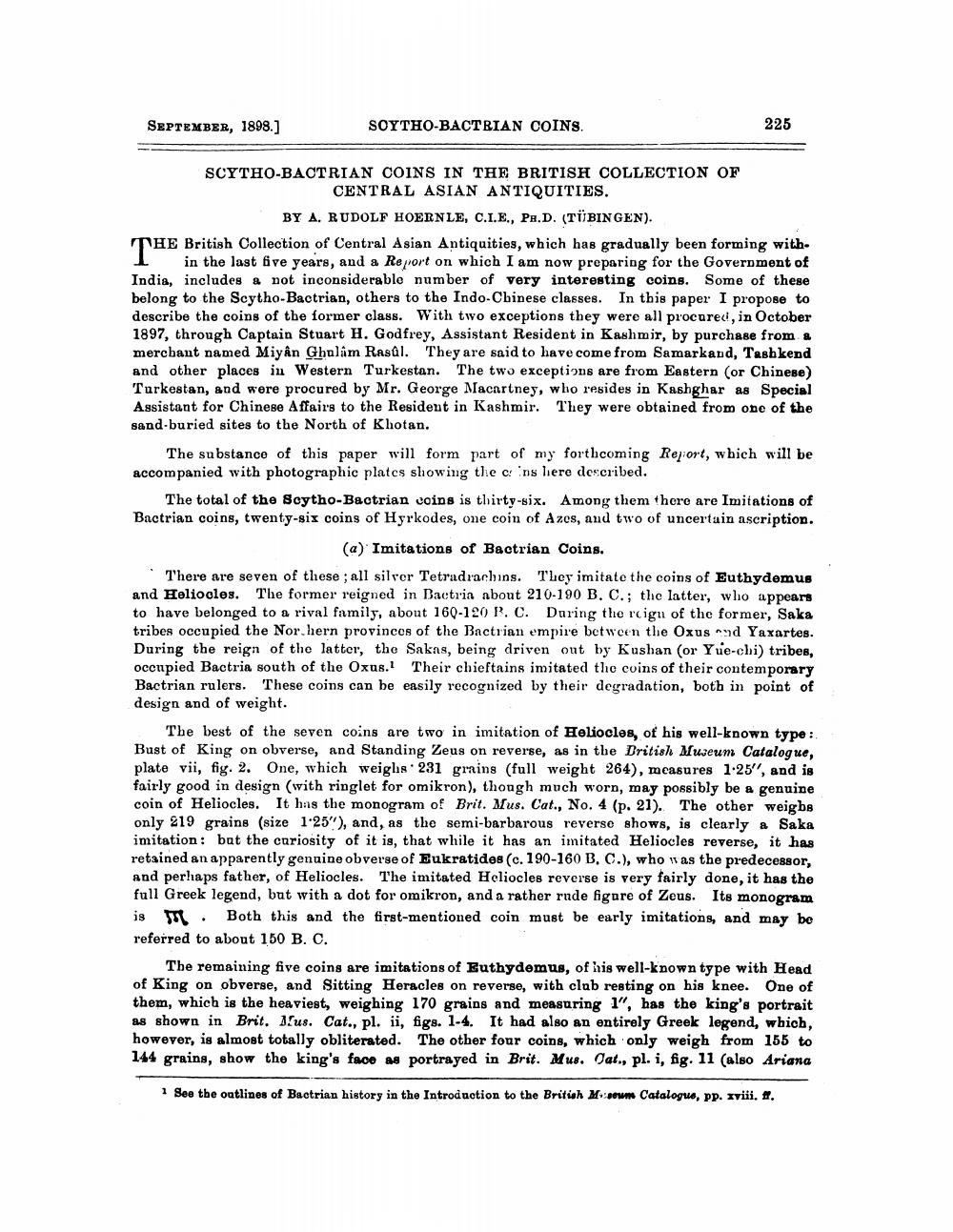________________
SEPTEMBER, 1898.]
SOYTHO-BACTBIAN COINS.
225
SCYTHO-BACTRIAN COINS IN THE BRITISH COLLECTION OF
CENTRAL ASIAN ANTIQUITIES.
BY A. RUDOLF HOERNLE, C.I.E., PR.D. (TÜBINGEN). The British Collection of Central Asian Antiquities, which has gradually been forming with 1 in the last five years, and a Report on which I am now preparing for the Government of India, includes a not inconsiderable number of very interesting coins. Some of these belong to the Scytho-Bactrian, others to the Indo-Chinese classes. In this paper I propose to describe the coins of the former class. With two exceptions they were all procured, in October 1897, through Captain Stuart H. Godfrey, Assistant Resident in Kashmir, by purchase from a mercbant named Miyên Ghulam Rasûl. They are said to have come from Samarkand, Tashkend and other places in Western Turkestan. The two exceptions are from Eastern (or Chinese) Turkestan, and were procured by Mr. George Macartney, who resides in Kashghar as Special Assistant for Chinese Affairs to the Resident in Kashmir. They were obtained from one of the sand-buried sites to the North of Khotan.
The substance of this paper will form part of my forthcoming Report, which will be accompanied with photographic plates showing the coins liere described.
The total of the Soytho-Bactrian coins is thirty-six. Among them there are Imitations of Bactrian coins, twenty-six coins of Hyrkodes, one coin of Azes, and two of uncertain ascription.
(a) Imitations of Bactrian Coins. There are seven of these ; all silver Tetradrarhins. They imitate the coins of Euthydemus and Heliooles. The former reigned in Bactrin about 210-190 B. C.; the latter, who appears to have belonged to a rival family, about 160-120 P. C. During the reign of the former, Saka tribes occupied the Nor.hern provinces of the Bactrian empire between the Oxusaud Yaxartes. During the reign of the latter, the Sakas, being driven out by Kushan (or Yue-chi) tribes, occupied Bactria south of the Oxus. Their chieftains imitated the coins of their contemporary Bactrian rulers. These coins can be easily recognized by their degradation, both in point of design and of weight.
The best of the seven coins are two in imitation of Heliocles, of his well-known type: Bust of King on obverse, and Standing Zeus on reverse, as in the Dritish Museum Catalogue, plate vii, fig. 2. One, which weighs. 231 grains (full weight 264), measures 1.25'', and is fairly good in design (with ringlet for omikron), though much worn, may possibly be a genuine coin of Heliocles. It has the monogram of Brit. Mus. Cat., No. 4 (p. 21). The other weigbe only 219 grains (size 1.25'), and, as the semi-barbarous reverse shows, is clearly a Saka imitation : but the curiosity of it is, that while it has an imitated Heliocles reverse, it has retained an apparently genuine obverse of Eukratides (c. 190-160 B. C.), who was the predecessor, and perhaps father, of Heliocles. The imitated Heliocles reverse is very fairly done, it has the full Greek legend, but with a dot for omikron, and a rather rude figure of Zeus. Its monogram is . Both this and the first-mentioned coin must be early imitations, and may be referred to about 150 B. C.
The remaining five coins are imitations of Euthydemus, of his well-known type with Head of King on obverse, and Sitting Heracles on reverse, with club resting on his knee. One of them, which is the heaviest, weighing 170 grains and measuring 1", has the king's portrait as shown in Brit. Mus. Cat., pl. ii, figs. 1-4. It had also an entirely Greek legend, which, however, is almost totally obliterated. The other four coins, which only weigh from 155 to 144 grains, show the king's face as portrayed in Brit. Mus. Oat., pl. i, fig. 11 (also Ariana
1 See the outlines of Bactrian history in the Introduction to the British M
own Catalogue, pp. xviii. .




